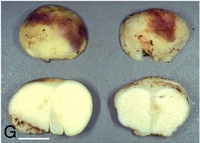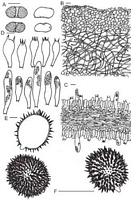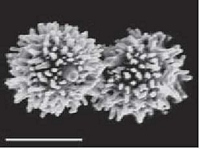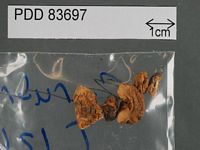|
 Russula rubrolutea Russula rubrolutea
SynonymsMacowanites rubroluteus
BiostatusPresent in region - Indigenous. Endemic
Images (click to enlarge)
Caption: Fig. 3 G, Macowanites rubroluteus; Scale bar = 10 mm. | 
Caption: Fig. 14 Macowanites rubroluteus. A, Basidioma; B, peridiopellis and peridial context; C,
hymenophoral trama and hymenium; D, basidia; E, hymeno | 
Caption: Fig. 15 Spores of Macowanites rubroluteus. Scale bars= 10 mm. | 
Caption: Dried type specimen
Owner: Herb PDD | |
Article: Lebel, T. (2002). Sequestrate Russulales of New Zealand: Gymnomyces and Macowanites. New Zealand Journal of Botany 40(3): 489-509 (http://www.rsnz.org/publish/abstracts.php).
Description: Basidiomata 7-18 x 10-24 mm, globose to subglobose, margin incurved to completely
enclose the gleba forming a slight basal indentation. Peridial surface dry, smooth, ivory to pale
yellow with somered tints or overall dark red. Gleba ivory to yellowish white, loculate, the
chambers minute, similar in size. Stipe 3-8 x 2-3 mm, cylindrical, solid, inserted centrally,
protruding from basal indentation, greyish to off-white, easily broken off. Columella 1-2
mm wide, percurrent or not, white. Odour and taste mild. Latex absent. Peridiopellis 50-65 µm
wide, a trichodermium of 5-8 tiers of cells 5-7.5 x 6-12 µm, with patches of upright hyphal
tips 7-10 x 3-4.5 µm which collapse to form an amorphous tan-brown to golden layer. Peridial
context 45-150 µm wide, of interwoven, ± parallel, hyaline hyphae 2-3 µmdiam., with some
scattered, refractive, inflated elements 5-7 µm diam. Endocystidia and sphaerocysts absent.
Stipitipellis 11-18 µm wide, an ixocutis of compacted hyphal tips 2-4 µm diam. Stipe context
of interwoven, hyaline hyphae 2-4 µm diam. Hymenophoral trama 12-23 µm wide, of loosely
interwoven hyphae 2-3.5 µm diam. and infrequent, elongated inflated elements, 4-7 µm diam.,
sphaerocysts absent. Subhymenium 9-15 µm wide, with 1-2 tiers of isodiametric cells 5-11
µm diam. Basidia 25-37 x 10-12.5 µm, clavate, hyaline, with 2 and 4 slender to robust
sterigmata 5-7.5 µm long. Cystidia 42-75 x 9-11 µm, clavate to cylindrical, though usually
tapered slightly at base, with granular contents; arising at base of the subhymenium, scattered.
In young specimens, maybe abundant. Spores 9-11 x 8-10.5 µm (9.79 ± 0.48x 8.96 ± 0.51),
Q = 1.06-1.11, subglobose, orthotropic. Ornamentation amyloid, crowded, of
isolated spines 1-2 µm high, narrow to robust, straight or
curved. Hilar appendix central, straight, prominent, 1.5 x 2 µm; plage absent. Spore colour in
mass white.
Habitat: HABITAT AND DISTRIBUTION: Hypogeous to emergent in small to large groups, under
leaf litter in forests of Nothofagus solandri, N. menziesii, andLeptospermum scoparium.
Fruiting period Sep-Dec.
Notes: ETYMOLOGY: The specific epithet refers to colour of the basidiomata, from the Latin ruber
meaning red, and luteus meaning yellow.
NOTES: Macowanites rubroluteus is one of two species of Macowanites with red tints or an
overall red peridium to be described from New Zealand. Macowanites carmineus has a more
robust stipe and the gleba is sublamellate rather than loculate as in M. rubroluteus.
Microscopically, M. rubroluteus has
a more organised trichodermial peridiopellis and subglobose spores ornamented with isolated
spines, whereas M. carmineus has an unorganised trichodermial peridiopellis and broadly
ellipsoid spores ornamented with aggregated warts forming an irregular partial reticulum.
Macowanites rubroluteus may be differentiated from the other new species, M. tapawera, by
the lack of olivaceous tints to the peridium or clavate peridial cystidia, and different spore
ornamentation. Macowanites rubroluteus resembles G. fuscus as the peridium may also appear
quite dark in M.rubroluteus, but a distinct stipe is always present in the former.
Microscopically, M. rubroluteus has 4-spored rather than 2-spored basidia, and has
large hymenial cystidia which G. fuscus lacks. M. rubroluteus also resembles Cystangium
sessile from Australia, but the gleba is loculate rather than sublamellate, the peridium has at
least some bright red tints, and the stipe is generally not as robust as in C. sessile (Lebel &
Trappe 2000). Microscopically, the peridiopellis of C. sessile is composed of larger cells
(11-25 µm diam. versus 5-7.5 x 6-12 µm) forming an epithelium, and the
spore ornamentation is slightly less crowded than in M.rubroluteus.
|